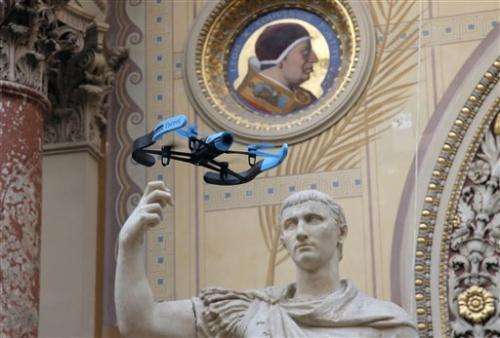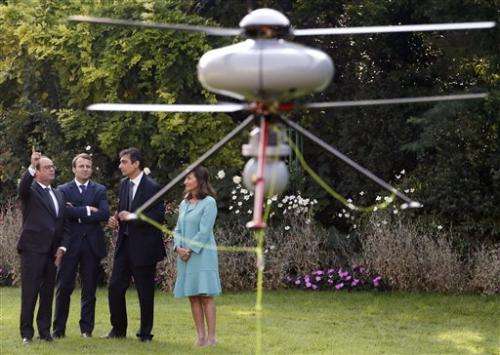To catch a drone: Govts seek ways to counter tiny fliers

What's the best way to counter an unwelcome drone: a bigger, faster drone, laser guns, sky-high netting or devices that block remote controls?
Scientists, governments and companies are now scrambling to find out.
Concerned about a recent spate of mystery drones flying over its nuclear plants, military installations and even the presidential palace, France has asked scientists to help devise ways to counteract the small—and so far harmless—motorized menaces overhead.
World powers such as China and the United States are also gearing up against the potential threat. Here's a look at the situation—and possible high-tech solutions.
___
WHAT'S THE PROBLEM?
Civilian drones have become a 21st-century hobby and a hot seller for many, from high-tech aficionados to curious kids. Companies like Amazon even want to use drones for deliveries. But their increasing presence in the skies gives headaches to national security chiefs: A small drone crashed on the White House lawn last week.
For months, France has faced dozens of drone overflights over sensitive sites—mostly nuclear facilities, a worrisome development in a country that gets the highest percentage of its energy in the world from atomic power.
French authorities say the drones currently present no threat. But some fear the drones could be spying on French technology or could one day be equipped with bombs or other weapons. Authorities have stepped up security at French nuclear sites and are investigating who might be behind the drone flights.
The possible risks of rogue drones include terrorism, the invasion of privacy, the theft of industry secrets, and "damage to the credibility of public authorities, institutions or companies," said France's National Research Agency.
___
HARMLESS, FOR NOW
Up to now, the intrusions have been innocuous: These are not rocket-blasting military drones the size of planes like those used by the United States against al-Qaida. But authorities are trying to head off the moment when advanced drones get into the hands of militants.
The one-by-one overflights by single drones, however, offer only a smidgen of the real potential threat. A recent tender by the U.S. Army focused on drone "swarms"—locust-like clouds of flying killer robots—and asked U.S. businesses to "develop and demonstrate a low-cost and lightweight countermeasure system that can be used to detect, disrupt, disable and neutralize enemy unmanned aerial systems platforms" in swarms.

A French security official said Germany, Britain, France and the U.S. were among the countries confronting the drone issue. He spoke on condition of anonymity because he was not authorized to speak publicly on the matter.
___
A CALL FOR CREATIVITY
On Tuesday, a French national security and defense agency under the prime minister closed the books on a call for bids to fund a drone interception system. It hopes to have at least some drone defenses operational in the next 18 months. The agency's classified list of 200 to 300 national companies considered "vital"—in sectors like energy, transportation and finance—would be among the likely early beneficiaries.
"We have made a proposal to the scientific community to see what best emerges," said Karine Delmouly, a project manager at the National Research Agency, or ANR, which is vetting the proposals. She declined to discuss specifics or say how many companies made bids.
The French security official said the call for proposals drew a substantial response.
___
WHAT'S THE GOAL?
France wants to monitor and detect intruding drones and their remote-control pilots; analyze and track their flight paths; and ultimately neutralize the drones—either temporarily or permanently—with the least collateral damage possible, the ANR said in its call for bids.
For developers, a winning bid could offer an entree into a huge potential market in the coming years.
___
HIGH TECH OPTIONS
As for the options, the sky may be the limit. Anti-drone devices could include pinpoint radar systems to track drones the size of a breadbasket or even smaller (and distinguish them from birds); high-tech lasers to destroy the unwanted intruders or telecommunications-scrambling systems to block the remote controls that direct them. Interception drones could be sent up into the sky to fight back and low-tech solutions such as sky-high netting or fences could also work, officials say.
___
ALREADY WORKING ON IT
Some countries are already working to counter unwanted drones. State media in China say Chinese scientists have developed a laser weapon that can detect and shoot down small, low-flying and slow-moving aircraft inside a 2-kilometer (1.2-mile) radius.
Private-sector companies are also tackling the problem. China's DJI Technology Co. said Wednesday it will send a software update this week for its drones' navigation system that will block them from flying over Washington, accelerating the release after the White House incident involving its 50-centimeter-long (two-foot-long) Phantom quad copter. Company spokesman Michael Perry said the DJI drones use a GPS-linked navigation system that already blocks them from "no-fly" zones around 700 airports worldwide.
___
LET'S SEE ONE IN ACTION
French media in recent days picked up a promotional video from Malou Tech, a small startup linked to telecommunications company Groupe Assmann, that showed a six-bladed black drone carrying a net which intercepts and catches a smaller red drone. The company chief, Philippe Dubus, said the firm was not taking part in the French bid, calling instead to encourage the responsible use of civilian drones.
"This is a technology phenomenon, not an aeronautical phenomenon," said Dubus, adding "within 18 months, whatever they come up with will be obsolete already."
Still, his company carried out tests Wednesday in which a DJI F550, a relatively old-model drone, successfully dropped a half-liter (16-ounce) bottle of water by remote control.
"In other words, everything is possible," he said.
© 2015 The Associated Press. All rights reserved.



















